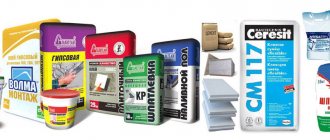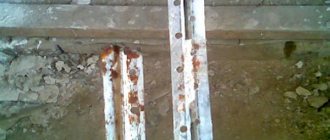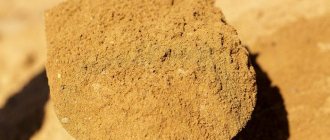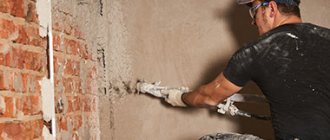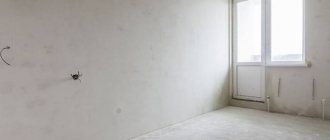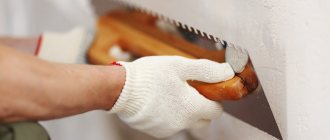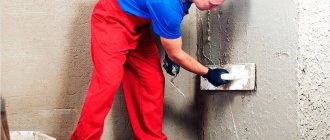Features of homemade and purchased mixtures
Ready-made plaster compositions cost quite a lot of money. This is explained by the carefully selected proportions of the quality components included in their composition. In addition to high-grade cement and carefully sifted sand of a certain fraction, such mixtures can contain a variety of improving additives, thanks to which the plaster acquires special characteristics. For example, increased plasticity, frost resistance or an extended hardening period.
Working with ready-made mixtures is easier and faster, which is why finishing craftsmen always prefer them to homemade ones. However, for the customer, price is of no small importance, and if the scale of work is large, he will choose the second option, since preparing a solution for plastering walls from individual components will definitely cost less.
The solution can be made directly on site Source kraski-net.ru
As for the special properties, they can also be imparted to homemade plaster using special components introduced into it, which will be discussed below.
In a word, its main advantage is the reduction in the cost of rough finishing for a large volume of work. Moreover, even taking into account the fact that all components will have to be delivered to the construction site separately and a mortar mixer will have to be purchased or rented.
A homemade solution is more profitable if you need to plaster all the facades or all the internal walls in the house. A concrete mixer will also serve in the manufacture of concrete screed on the floor. But such work will take more time, so in each case you need to decide what is a priority.
A concrete mixer will significantly speed up work Source www.chipmaker.ru
Another disadvantage is the risk of producing a low-quality mixture that will not stick to the surface, crack during the shrinkage process, or crumble later. Therefore, before preparing cement mortar for plastering walls, the proportions of all components must be accurately determined. Moreover, they all must be of proper quality.
How to plaster with gypsum mortar (video)
You can work with gypsum plaster using a plastering station or manually. Machine application is a separate topic for discussion, and we will consider it in another article. And here we will analyze the nuances of manual application.
- the thickness of each layer can be 30-50 mm; if necessary, a new layer can be applied only after the previous one has dried;
- dry mixture consumption in the absence of large irregularities with a layer thickness of 1 cm is on average 9-10 kg/m2;
- gypsum mortar can be applied not only to brick, concrete surfaces and aerated concrete, but also to the previous layer of cement or gypsum plaster;
- surface leveling is carried out using beacon profiles or gypsum beacons - a small amount of mixture, which is applied pointwise or along a line to the wall and leveled; after they have dried, a mortar is poured between them, and then the entire plaster mass is leveled using building rules; the thickness of the layer will be equal to the height of the beacons;
- to remove dust, protect against the shedding of small particles and strengthen the surface after plastering, the surface must be primed;
- to obtain a flat surface, the walls are additionally puttied before painting or gluing thin wallpaper;
The video below shows all the stages of finishing: how to properly knead, apply and grout.
What are the types of cement mortars?
Before starting work, you need to decide what kind of solution is needed for plastering the walls. There are not many types and they differ in the presence of a certain amount of additional ingredients that give the mixture special characteristics.
Sand-cement
A simple cement-sand mixture is the most versatile. It applies:
- for finishing interior spaces and facades;
- for initial and final alignment;
- for rooms of any purpose.
Sand and cement combined with water form a monolithic stone-like mass that is resistant to both moisture and mechanical stress. This makes it possible to decorate walls with a wide variety of operating conditions. These include facades that are in constant contact with the atmosphere with all its climatic factors, living rooms, and rooms with high air humidity.
Plastering the facade by machine Source i.ytimg.com
The difference between leveling and finishing mortar is the use of sand with a specific grain size. If coarse sand with a certain amount of impurities is suitable for rough finishing, then for finishing you need clean filler of the smallest fraction.
Note! Before preparing cement mortar for plastering smooth concrete or painted walls, they need to be roughened by applying a special primer or making notches, since this mixture does not adhere well to such substrates.
Primer Concrete contact with abrasive additives will improve surface adhesion Source stroy-podskazka.ru
Sand-cement with lime
This type of plaster differs little from the previous one, but has additional properties:
- Plastic. Lime increases plasticity and makes it easier to apply the solution to the surface.
- Better vapor permeability.
- Extended hardening period: if a cement-sand mortar “lives” no more than an hour after preparation, then you can work with a cement-lime mortar for 3 hours.
- Good adhesion to smooth substrates.
- Bactericidal properties - lime prevents mold from forming on the walls.
Plaster with the addition of lime is an excellent leveler for facades and walls in wet rooms Source otdelka-expert.ru
See also: Contacts of companies that specialize in finishing materials
But you need to know how to properly prepare a mortar for plaster from cement, sand and lime, because a violation of the proportions can cause the appearance of limescale efflorescence on the surface, which is incompatible with some types of finishing materials.
Sand-cement with gypsum
The addition of gypsum makes the solution stronger, and the finished surface is easy to sand. But this plaster hardens very quickly, so it requires skill in working or preparing the mixture in small volumes.
It is important! Unlike the two previous types, cement-gypsum plaster is afraid of moisture, so it is used only for interior decoration and exclusively in rooms with dry air.
Due to better plasticity, such plaster is more convenient to apply Source gid-str.ru
The characteristics of any plaster can be “adjusted” to the conditions in a particular room using various additives.
With their help, they increase the strength, moisture resistance, frost resistance of the finished coating, increase the plasticity of the solution, its adhesion to the leveled surface, extend the “survival” period, etc.
Types of gypsum plaster
There is a certain gradation of parameters according to which gypsum plasters are selected. They can be divided according to the following parameters. Application technology:
- Manual – application work is carried out using manual equipment and tools;
- Mechanized - for productive finishing using special equipment.
Special purpose:
- Base layer (rough). Basic plasters have a larger grain size, which allows them to be applied in a thicker layer. Suitable for leveling walls and ceilings, local elimination of defects. You can glue tiles to the surface, apply decorative plaster and other facing materials. The thickness of gypsum plaster applied in one layer can reach 50-80 mm for some brands.
- Finishing layer (finishing). A mixture of fine grinding with a grain size of up to 0.63 mm, which provides a perfectly smooth surface, the layers are easily combined. The thickness of gypsum plaster during final application can start from 2 mm and reach up to 50 mm.
By place of application:
- Only for vertical surfaces (walls);
- Universal (ceilings and walls);
- High-strength for floors (compressive strength 4 MPa or more).
According to operating conditions:
- For dry rooms;
- Acceptable for bathrooms and kitchens with periodic increases in humidity levels up to 75%, provided they are protected from direct contact with water.
Selection of quality components
Before preparing cement mortar for plastering walls, you need to prepare all the components.
Binder
Cement is the main ingredient of the mixture, binding all other components into a monolith, giving the surface strength, hardness, and resistance to moisture. It comes in different origins, different strength grades, with or without additives.
The choice of proportions depends on the brand of cement: the higher it is, the less cement and more sand is required. Knowing the proportions and simple calculations allows you to find out what is more profitable to buy for preparing a certain brand of mortar: inexpensive, low-grade cement in large quantities or high-strength and expensive cement, but in smaller quantities.
What kind of cement is used for plastering?
Usually, to prepare the plaster composition, Portland cement of at least 400 grade is used, sometimes 500 grade is used. Many people have knowledge and experience about the proportions of components for mortar, but are not always able to select the brand of cement for a certain type of plaster mixture. To carry out work on a large area, where there are a small number of corrections, or to level the surface of walls, use the 400 grade of the first type, these instructions can be found on the packaging. Cement is well suited for plastering external walls; it is used at high humidity and low temperature.
The second type of cement is distinguished by special additives that reduce the internal stress of concrete and cement castings, improve ductility, and frost resistance. This type of cement is used when leveling walls.
Video description
When choosing this product, it is important to pay attention to its expiration date, packaging, and storage conditions. More details about this in the video:
Filler
Sand is a filler of the mixture, on which its strength, density and other characteristics depend. The quality of the sand and the grain size are important:
- Cheaper quarry sand, which may contain clay and organic impurities, is only suitable for rough leveling even after preliminary screening.
- Improved compositions for final leveling are made from clean river or washed quarry sand of a fine fraction.
On a note! For plastering ceilings, it is recommended to add lime to the solution, which improves the adhesion of the leveler to the surface.
Purpose of the components of the plaster mortar
As we already know, the plaster mixture consists of many different components. Each of which is important and performs its own functions. An excess or deficiency of one of the components of the solution will lead to a loss of quality. That is why it is important to know the purpose and functions of the components of the mixture.
Binder in plaster mortar
If the plaster solution contains only one binder, the composition is called simple. If there are two or more binders - complex. Not all binders get along with each other. For example, gypsum and cement are chemically unfriendly to each other. Therefore, they are used separately or with other binders.
All binders, except polymers, are mineral substances, which is why plasters have the same name. Gypsum, cements and lime are pre-treated thermally, as a result they lose water and are able to react to its presence. When combined with water, these substances form saturated solutions and create crystals.
Liquid in plaster
The solution usually contains more water than is required for crystal formation. Liquid is also needed to give the mixture mobility (workability). In this case, excess moisture can be harmful (the strength of the solution decreases). It is for this reason that the ratio of water and other components must be observed.
Fillers
The production of binders, in addition to clay, requires a lot of costs, so they are much more expensive than fillers such as sand or sawdust. In addition, a solution containing only binders cracks when hardening. Therefore, to reduce the amount of binders (the cost of the solution), as well as to reduce cracking, fillers are introduced into the composition.
Fillers also give solutions a certain structure, for example, coarse sand is used for “bark beetle”; for other decorative mixtures, artificial or natural fibers and shell fragments are used as fillers.
It is better to purchase decorative mixtures ready-made. Their composition was developed and tested in practice by specialists.
Rough (leveling) plaster more often than other components has to be prepared on site. The consumption of leveling plaster mixture is higher, and the cost of a mixture prepared by yourself is lower.
Special additives for plaster mortars
To provide the plaster solution with the desired properties, modifying additives (universal and narrowly targeted) are used. Additives affect the binder (cement), enhancing or neutralizing its individual properties.
In solutions, additives perform the following functions:
- accelerate/slow down the process of crystal formation (setting), for example, for gypsum, the retarder is bone glue, milk, PVA;
- increase frost resistance (ferric chloride and other salts);
- improve plasticity (serve for some retention of water in the solution, prevent the process of delamination of the mixture), for example, liquid glass;
- increase the strength of the mixture (for example, reinforcing fibers (fiber) or additional binders).
Cooking technology
When buying ready-made plaster, you don’t need to think about the proportions and technology of its preparation, because all the components in it have already been selected and mixed, and all that remains is to pour in water and knead according to the instructions printed on the bag.
Another thing is a homemade solution, the quality of which depends entirely on the master. And one of the most important points is determining the proportions of all components.
Proportions of materials
It was already mentioned above how to make a mortar for plaster from cement and sand: the proportions of these components depend on the brand of binder and the desired strength of the finished mixture. As a rule, these proportions are determined in volumetric units or parts, since weighing bulk substances at a construction site is much more difficult than measuring with buckets or other containers of equal volume.
Compliance with proportions is a guarantee of the quality of the solution Source i.ibb.co
Below is a table of the ratio of the main components indicating the brand of cement used and the brand of the finished mortar. The proportions for lime are given as a guide; adding it is not necessary and does not change the ratio of the main parts.
Table for determining proportions Source i.ibb.co
How to dilute and mix for plaster
The principle of creating consistency is somewhat different when preparing a solution for plaster. In some cases, additional impurities are added .
To prepare the mixture you should:
- mix cement and sand in a container using a ratio of 1 to 3 (1 part cement and 3 parts sand). It is necessary to take cement grades M150, M200; they showed themselves best when plastering interior spaces. For increased strength, you can use M300, but it is more often used for outdoor work;
- gradually add water and stir the solution, its amount usually corresponds to 1 to 1 to cement;
- If necessary, you can add lime or clay; these components soften the composition and make it easier to apply thin layers. For lime, the ratio is 0.5-0.7 to 1 share of sand;
Additive ratios
- check for proper consistency.
If due to any errors you get a thick solution, you need to add more water; otherwise, you can add a little to the mixture, but this may negatively affect the homogeneity of the mass. Some people add a thickener in this case.
It should be noted that the time to use the mixture is limited . Most solutions must be used within 1.5 hours; some, such as concrete, can be easily used within 1 hour.
If the solution is not worked out within this time, it will begin to harden and will no longer be plastic; applying such a consistency will lead to its crumbling soon.
Video description
The procedure for preparing the plaster is described and shown in this video:
Mix all the components in a concrete mixer or in a container with a construction mixer. At the end of the kneading, dip the trowel into the solution:
- If the mixture sticks to the spatula and does not flow well, you should add a little sand to it - the greasy solution will be difficult to distribute over the surface.
- If it is glassy, leaving almost no trace, add cement - the thin solution will not stick to the base.
- A normal mixture will leave behind an even, thin layer without lumps.
Consistency of high-quality freshly prepared mortar Source 1beton.info
Features of the composition for plaster
To prepare a high-quality composition, all dry materials are sifted through a special sieve. The solution is ready for work if it has a homogeneous mass, the required fat content, and is well retained on the surface and does not crack after drying.
Solutions can be lean or have high or normal fat content. Fatty compositions include a high content of binder, as a result of which cracks appear on the plastered surface. With normal composition, all components are added in the correct proportions. Lean mixtures have a large amount of filler, while the plaster layer loses strength, but the coating does not shrink or crack.
Determine the fat content with an object used to mix the solution. If the mixture sticks strongly, then it has a greasy composition; it is necessary to add a filler, that is, sand. If there is no adhesion, the composition is considered thin, so you need to add a binder. The solution is considered acceptable for use if adhesion is of medium degree.
Briefly about the main thing
If you need to plaster the outside of the house or level all the walls inside, the most economical solution will be a homemade solution of sand and cement. It may consist only of these components and water, or it may contain various additives. What mortar to make for plastering walls in a house yourself depends on the conditions under which it will have to “work.” But in any case, it should be prepared from high-quality materials and in compliance with proportions. And if it is necessary to improve its properties, it is recommended to use special modifiers. A high-quality solution should be homogeneous, without excess water.
Ratings 0
Proportions of mortar for plastering walls with your own hands
The topic of this article is mortar for plaster, but not a general description and tips for use, but specific information about the composition and proportions. This information will help you achieve the desired result of the repair: excellent appearance, strength and durability of the coating.
Plaster solutions are used for various purposes, for example, for leveling or decorating facades or interiors. But an important function of the plaster composition remains the protection of external and internal structures of buildings from various influences.
In order to prepare the required composition for plaster with your own hands, you need to have an idea of the correct proportions of the components (volume or weight). You also need to know in what form and in what order the components are mixed.
What components are needed to prepare the mixture?
Many beginners, trying to make a plaster solution with their own hands, disrupt the mixing process from the very beginning. This is very important, since the key characteristics of the finished composition depend on high-quality and correct mixing. The main components include water, filler and binder. If necessary, additional materials are introduced, including various additives and plasticizers.
Clay and lime can play the role of a binder. But the most popular and in demand is cement. It is excellent for preparing a mixture that is later used for exterior or interior decoration. At the same time, it is the most expensive option, since the other ingredients are seriously inferior to it in terms of quality, reliability and strength.
When choosing among many varieties, the easiest way is to choose M400 cement. This dry mixture is universal because it meets all the requirements of GOST, as well as apartment owners. Excellent for treating bathrooms, kitchens, hallways and, of course, living rooms. If the budget is limited, and repairs are carried out in low-impact structures, such as basements or plinths, then a rational solution would be to purchase M300 Portland cement.
The strength of plaster is influenced by many factors, but the most important is the brand of cement. The higher this indicator, the better the quality of the solution.
For exterior decoration, experts recommend giving preference to products designated M500. Such products showed their best performance in conditions of high humidity and constant temperature changes.
Having decided on the binder, all that remains is to deal with the filler. Here the only and undisputed favorite is ordinary sand. It is recommended to take pure river fine fraction, which will ensure maximum mixing of all the ingredients of the future plaster. Together with cement, it forms an ideal material characterized by resistance to cracking and a high level of strength.
The simplest and most popular proportion for preparing a cement-based plaster mixture includes one part of binder and three parts of sand. This recipe is suitable for almost any room. Water is added until the essence reaches the required viscosity level. For rooms with normal moisture levels, you can add a little more filler. If you want to achieve plasticity, then the correct ratio involves using one portion of cement and two parts of sand.
There are many plasticizers and additives designed to increase the softness and pliability of the finished plaster, change the hardening time and various characteristics of the solution. Home craftsmen often add detergents, soaps, and adhesives like PVA. Thanks to such materials, the adhesion of the essence to the concrete base improves, and the level of protection against fungal bacteria and mold increases.
A big misconception is associated with the technology of mixing the mixture. For some “experts,” the order in which components are added does not matter. Many people first pour water into a container, then pour in cement, sand, lime and other materials. The problem is that the dry substance, after entering the liquid, turns into small lumps. It will take a lot of effort to stir them until the desired consistency is achieved.
In order for the solution to be high-quality and homogeneous, experienced craftsmen advise performing the following steps:
- Initially, you need to sift the sand using a sieve with small cells. Otherwise, all debris and large particles such as shells, pieces of silt, pebbles, and organic debris will end up in the solution. During plastering, they will leave grooves on the surface of the wall, clinging to the spatula.
- After this, you need to pour dry cement into the sand and mix everything thoroughly. If the filler is wet, it will need to be dried - mixing will be much easier when both components are dehydrated.
- Only after this is water added, and gradually, while the solution itself is constantly mixed. It is recommended to pour in new portions of liquid at a time when it is almost impossible to interfere.
Consumption of cement plaster
Calculate the thickness of the plaster layer:
- we clean the surface of the old finish, remove the weak layer, and, if necessary, knock down strong irregularities;
- we identify the most convex place, hang the wall, put stamps on the ceiling;
- in 3-5 places, place a ruler perpendicular to the surface, measure deviations from the plane, add up, calculate the average;
Example:
Wall 8 m2, deviation measurements: (3+6+1+4+1): 5=3 cm middle layer of plaster. If you plan to plaster on finished beacons, it is important to take into account the thickness of the guides, from 3-10 mm, depending on the model, we will take 3 mm, we get a plaster layer: 3 + 0.3 = 3.3 cm.
Different types of cement and gypsum mixtures have different consumption per 1 m2, usually the data is indicated on the packaging. So, the average is 8.5 kg of dry composition per 1 m2, layer 10 mm.
Calculations: 8.5 * 3.3 (thickness of our layer) = 28 kg of mixture will be required in our case per 1 m2, which means to plaster our 8 m2 wall: 28 * 8 = 224 kg. An average bag contains 30 kg - 224:30 = 7.5 m. This is quite a large amount and will require significant financial investments. Homemade cement plaster will cost 2-3 times less, its standard consumption is regulated by SNiP, and is indicated in tables for different surfaces and application methods. For example, for a porous base made of foam concrete, aerated concrete, the consumption will be greater than for plastering monolithic concrete structures.
Table of cement mixture consumption for plastering surfaces of various types, per 100 m2
Brands of plaster mixture
There are the following brands of plaster mortar:
- M25 - used for surface grouting.
- M50 – finishing of walls and partitions in dry rooms.
- M100 – finishing of load-bearing structures.
- M150 - used for finishing facades for cladding and interior walls.
- M250-300 – finishing of external surfaces for painting and use indoors with high humidity.
The digital designation determines the purpose of the material, its strength and resistance to water and temperature changes.


